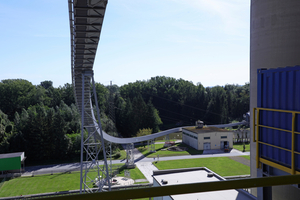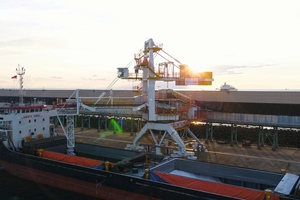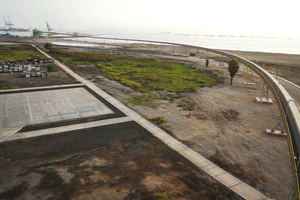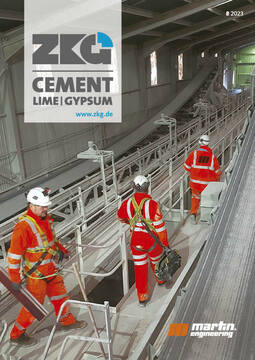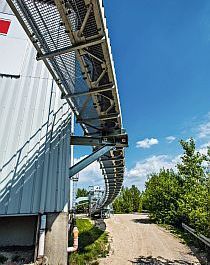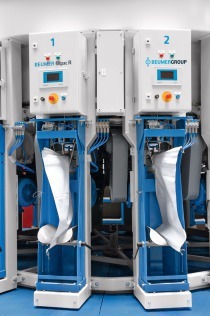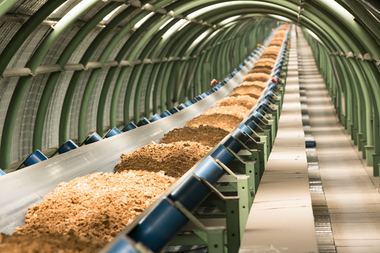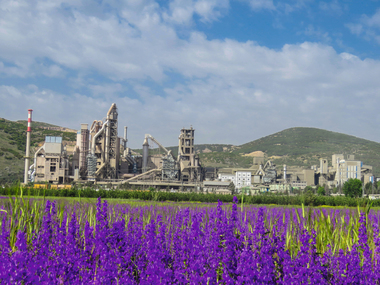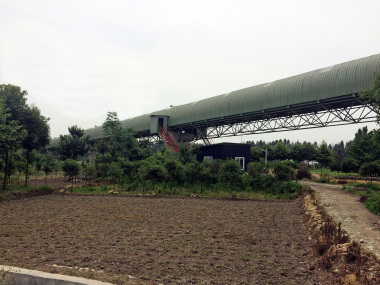Beumer Group supports bulk material terminals at ports: Adapting to ever-changing circumstances
Dry bulk ports and terminals are in a state of constant change. The materials they handle change and so, too, do the quantities. Operators are constantly having to adapt to new requirements. They want to automate their activities as much as possible while also remaining flexible. They need more space for future expansions, and they are constantly facing the challenge of adapting their facilities to the increasing throughput, while at the same time paying ever more attention to avoiding dust emissions and improving their CO2 footprint. In projects such as these, Beumer Group works together closely with its customers to develop efficient and new solutions.
The ability to load ships quickly is a decisive productivity factor. It is important to adapt the technology implemented in ports to the local space constraints and the size of the vessels – as well as to take account of the characteristics of the transported material. “Ports are faced with the challenge of increasing their performance,” explains Lukas Paul, Head of Ports & Terminals at Beumer Group. To remain competitive, operators must constantly expand their terminals. “That is just one of the challenges. It is necessary to ensure economically viable and environmentally responsible operation and, first and foremost, cost efficiency.” When it comes to dry bulk handling equipment, Beumer Group is there to help. The system provider supports operators – starting with every aspect of conveyor technology and through to the loading of the ships.
“When customers come to us, we sit down with them and talk,” explains Beumer expert Paul. “In most cases, they know their everyday workflows extremely well and are aware of where the weak points and bottlenecks are.” To ensure the efficient handling of dry bulk, they must constantly adapt or expand their terminals. However, the restricted space available in ports often presents a difficulty. This means that operators face the challenge of integrating new storage areas – and these are not always in the immediate vicinity of the port. To use these areas, environmentally friendly conveyor systems represent an alternative to trucks.
Belt conveyors as a cost-efficient alternative
Belt conveyors can be used to transport various bulk materials from and to the port. Beumer Group supplies a variety of solutions depending on the intended use. Troughed belt conveyors, for example, permit high mass flows. They have an open design and are therefore suitable for coarse materials and very large volumes. Pipe conveyors, by contrast, have other specific advantages. The idlers shape the belt into a closed tube. This protects the transported material against external influences and also protects the environment against emissions such as dust or material loss. Panels with hexagonal cutouts and idler rollers in an offset arrangement keep the tube closed. Pipe conveyors are able to cope with tighter curves and larger angles of inclination than are possible with an open troughed belt conveyor. Their enclosed design also enables them to handle various bulk materials securely without any danger of cross-contamination. They also protect the health of the people who work at the facility or live nearby – for example, when bulk metal concentrates are being transported.
Lukas Paul remembers a project in Peru. To transport zinc, copper or lead concentrates mined by a number of different companies from the store to the terminal, the system provider installed a pipe conveyor measuring approximately 3000 m in length which transported more than 2000 t of this material per hour. However, there was a problem: The route passed through a military area with barracks for troops. The enclosed conveyor system reliably prevents the concentrates from coming into contact with the environment and conveys them to the ship’s holds without generating dust. The pipe conveyor is also equipped with filters, scrapers, a dust removal mechanism and a control system, making the need for any transfer points superfluous. “Our belt conveyor systems are an economical and environmentally friendly alternative to truck transport,” says Paul. “They allow operators to automate their processes and remove the burden of the manual work from their employees. This solution also reduces energy consumption.”
Adapting for improved performance
Sometimes the bottleneck can be a transfer chute. The facilities are already designed to cope with large volumes of bulk materials, but the transfer chutes through which the material moves from one conveyor to the next are not. “That was true of one of our customers,” reports Paul. In this case, the experts at Beumer were able to perform a DEM analysis which enabled them to adapt the chutes and eliminate the bottleneck.
“When we talk to our customers and analyze the processes, we very soon see whether a technical solution to the problem already exists,” says Paul. An example? Beumer Group supplied the conveyor technology for an iron ore terminal in Malaysia. “We were making a few small changes to improve plant performance when we discovered a new problem related to conveying iron ore in a particular condition,” recalls the Beumer expert: During the rainy season, the material that is to be transported can sometimes become wet and sticky. In this state, material sticks to the conveyor belt and over time is distributed along the complete conveyor route. There was no suitable solution for keeping the belt clean available on the market. “We had tried a number of different belt scrapers but that didn’t really help,” says Paul. Beumer’s technical experts developed a prototype that cleans the belt using very-high-pressure water. “In this way, we were able to remedy a problem for which there had previously been no solution.”
The U-shape conveyor was developed against a similar background. The challenge was to combine the advantages of open troughed and enclosed pipe conveyors: The transported material had to be protected against outside influences such as wind, rain or snow – while the environment had to be protected against potential escaping material and dust. The solution had to be equally suitable for coarse material as well as very fine material. And all this was made even harder by the sometimes complex routing. “In our U-shape conveyors, a special idler roller configuration forms the belt into a U-shape. This is how the bulk material is transported to the discharge station,” explains Paul. A similar idler roller configuration to that used in troughed conveyors is used to open the belt. In this way, Beumer Group has extended the possibilities for providing the best bulk material transport solution based on the specific need of the individual project.
From greenfield to brownfield projects
Beumer Group works not only on greenfield but also on brownfield projects – for example in the case of a fertilizer factory in Malaysia. To meet the growing demand for urea fertilizers, the system provider was commissioned to modernize and improve the performance of the existing system located between the longitudinal stockpile and the ship loading system. The project scope included not only a portal scraper and ship loader but also a fully automatic tripper car which fills the longitudinal stockpile, system monitoring and control equipment, adaptation of the motor control units, a transformer station, a transfer station and a screening station. The schedule was quite tight. However, the particular difficulty lay in finding space to install the new systems. “We had to install a new reclaimer in the warehouse. To do this, we blocked off a small section of the hall in order to construct the new reclaimer, which was approximately 50 m wide. We had to bring it in part-by-part through the back door and then assemble it during ongoing production,” describes Paul.
“During our discussions, it usually becomes clear to us straight away what the customer needs. As a result, we are often able to propose a solution very quickly.” However, the complex part lies in the actual implementation and identifying precisely where the problems lie. “Thanks to our experience with the pipe conveyor, we were able, for example, to form the belt on the U-shape conveyor into the required shape. However, we still had to find out whether the belt would run stably and whether there were any problems in shaping it,” says Paul. The answers to these problems become clear with time.
It is also important to adapt the systems to the bulk material – for example in the case of fertilizer. Here, it is necessary to make sure that certain components are manufactured from stainless steel. “We have to examine the application very carefully,” stresses Paul. “We can’t simply pick a solution off the shelf and be confident that it will function well in countless other applications.” It is important to have a precise understanding of the materials in order to adapt the design individually using the appropriate technical capabilities. This is the great strength of Beumer Group.
FAM has been part of the group of companies since May 2022. It plans, designs and manufactures turnkey plant and equipment for extracting, transporting, loading and storing minerals, raw materials and goods. “This allows us to provide an even more comprehensive service to port terminal operators, be it very large or also smaller systems,” says Paul.

